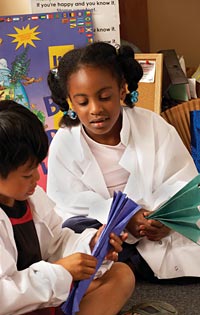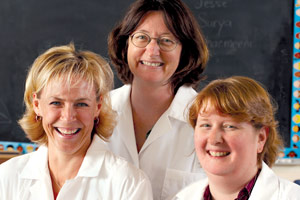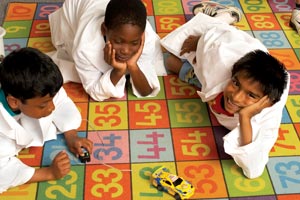
Inquiring Minds
There's scientific method in those lab coats
by Wendy Harris
Teaching Success
Teachers hope to lead Canada's Olympic class of 2006
by Teddy Katz
Nurturing the Naturals: Teacher-Parents at the Olympics
by Teddy Katz
A New Vision for the Profession
Changes proposed to teachers' ethical and professional standards
by Gabrielle Barkany
Transition to Teaching 2005
Underemployment in a mixed Ontario job market
by Frank McIntyre
Inquiring MindsTeachers participating in the first-ever Additional Qualifications (AQ) course provided by an Ontario school board – at the Toronto DSB for primary science and technology – found themselves part of a bold new experiment in more ways than one.They explored and developed models for teaching science and then put them to the test. Their classrooms became laboratories for experiments designed to uncover effective means of improving student learning in primary grades.by Wendy Harris |
 |
Scientific method – devising a hypothesis, creating experiments to test it and reaching a conclusion – is the underpinning for the action research conducted by participants in the science and technology AQ at Toronto DSB. Action research requires teachers to pose a question or questions related directly to their experience with students in their classrooms and to then answer the question through direct research.
Andrea Simsons, a Grade 2 teacher at Berner Trail Public School in Scarborough, and colleagues Patti Gould and Jean McDonald, who teach Grade 1, wondered how they could charge their young students with the thrill of discovery in science. They wanted the students to take ownership of their learning and to be excited by the scientific process. They wanted the children to imagine themselves as scientists, thinking this would encourage their involvement in learning.
After some preliminary research to find out what students thought about scientists, they came up with an experiment.
Proposition: enthusiasm
What would happen, they asked, if each child were given a white lab coat to wear while doing science? Would it alter the students' perceptions of themselves? Would it make them believe that they could participate directly in the scientific process, discovering for themselves the principles of science rather than waiting for teachers to give them the answers?
The teachers found some second-hand lab coats, then shortened and altered them – sometimes with liberal use of duct tape and staplers – to fit their students. Once the children donned the coats for classes the teachers were able to test their hypothesis. The findings were clear.
"Wow, did they ever respond," says Gould.
As flowered T-shirts and shirts emblazoned with hockey players and skateboarders were covered – at least part of the time – by pristine white lab coats, these budding scientists flourished.
"Children had expectations of what a scientist looks like and how a scientist acts," says Simsons. "With their lab coats on they saw themselves as scientists and they acted like scientists."
 |
Grades 1 and 2 teachers putting science to the test at Berner Trail Public School – Patti Gould, Jean McDonald and Andrea Simsons |
The teachers measured their students' learning in a series of written and verbal assessments. Following the wardrobe change the Grade 1 students were able to distinguish between studying science and studying math or other related subjects – a distinction they had previously failed to make. They also remembered more of what they learned.
In the Grade 2 class the children dramatically increased their use of scientific language. "They began calling a cloud a nimbus or a stratus rather than just a plain cloud."
The children's enthusiasm for seeing themselves as scientists was palpable and contagious: Children from other classes began clamouring for lab coats of their own.
The Berner Trail PS results come as no surprise to Mike Farrell, a partner in and director of research and strategy for Youthography, a research consultancy in Toronto that targets youth trends and issues. Farrell says it is critical to involve students in their own learning at younger and younger ages. As they grow older they will demand more and more autonomy, and for learning to be effective they will need it.
Empowered learning
"Any school board that doesn't provide empowerment at elementary levels is potentially creating very disengaged students," says Farrell. Primary-level students need structure – a solid pathway to guide their learning. "But they also want the freedom to find out how that path can move and morph, based on their own values and what's important to them."
Otto Wevers, a TDSB instructional leader in science and technology at the elementary school level, taught a section of the AQ course last spring. He says that empowerment of students and teaching solid inquiry and design skills – how to ask an excellent question, how to research it, investigate it and design an appropriate experiment to figure it out and come up with a good answer – are key.
“It's not so much the content; it's the process that will make them scientifically literate.”
"It's not so much the content; it's the process that will make them scientifically literate," says Wevers. "When kids are free to take risks without being afraid of making mistakes they do a lot more learning."
For many elementary school teachers this is liberating. It means they don't have to know everything. Furthermore, the inquiry and design skills they teach their students mirror the primary research that these teachers are being encouraged to pioneer in their classrooms throughout their teaching day.
Until this year university faculties of education were the main providers of AQ courses in Ontario. School board delivery of some AQ courses may improve access for many Ontario teachers. In the case of the science and technology AQ at TDSB, subsidies from the professional development budget allowed the board's employees to enrol for only $350 (compared to the usual $800-900 per 125-hour course).
Location, location
"Local AQ courses mean that more teachers in Ontario will be able to upgrade and update their skills," says Kevin Lowe of the College's Accreditation Unit. "Individual boards are also able to target identified needs of their teachers and students."
Wevers is particularly pleased that TDSB has been able to offer the science AQ. Science and technology have been waiting in the wings while attention was directed towards math and literacy skills. And that, he says, is unfortunate, given the fact that of the 10,500 teachers within the board only 600 had any kind of formal science and technology training. With the course offered to 105 teachers last spring, the percentage of teachers with science training jumped from six to seven per cent.
 |
Simsons says, "With their lab coats on they saw themselves as scientists and they acted like scientists." |
Catherine Little, another instructional leader in science and technology at TDSB who taught a section of the course, feels that school boards are ideally suited to providing AQ courses. Boards know teachers' needs, the specific resources available (such as TDSB's science kit for the elementary level) and the logistical issues for course delivery. Most importantly they can facilitate the creation of a learning community that will continue to function long after the course is over. "By meeting with the same group a couple of times a week, we can develop relationships that allow us to work more effectively," says Little.
Like all AQ courses, TDSB's science and technology AQ requires a hefty commitment of time. Teachers met twice a week, once after school for several hours and every Saturday, for a total of 125 hours over two months. The board offered the course again in the fall and plans to make both parts one and two available in the winter or early spring.
AQ dos
Since its inception almost 10 years ago, when the Ontario College of Teachers was made responsible for the accreditation of pre-service and in-service training for teachers, the College has encouraged diverse providers for AQ courses that deepen teachers' knowledge in particular subject areas, offer new challenges and improve professional standing.
As providers of AQ courses school boards make courses available to all qualified applicants – not only teachers in their employ.
Regulation 347/02 outlines nine main requirements for a potential provider to offer an AQ course. Among these are provisions that
- the course curriculum is relevant
- the program has clear goals
- instructors have Ontario teaching experience related to the program
- the integrity of student records is maintained
- both theory and practice are taught.





